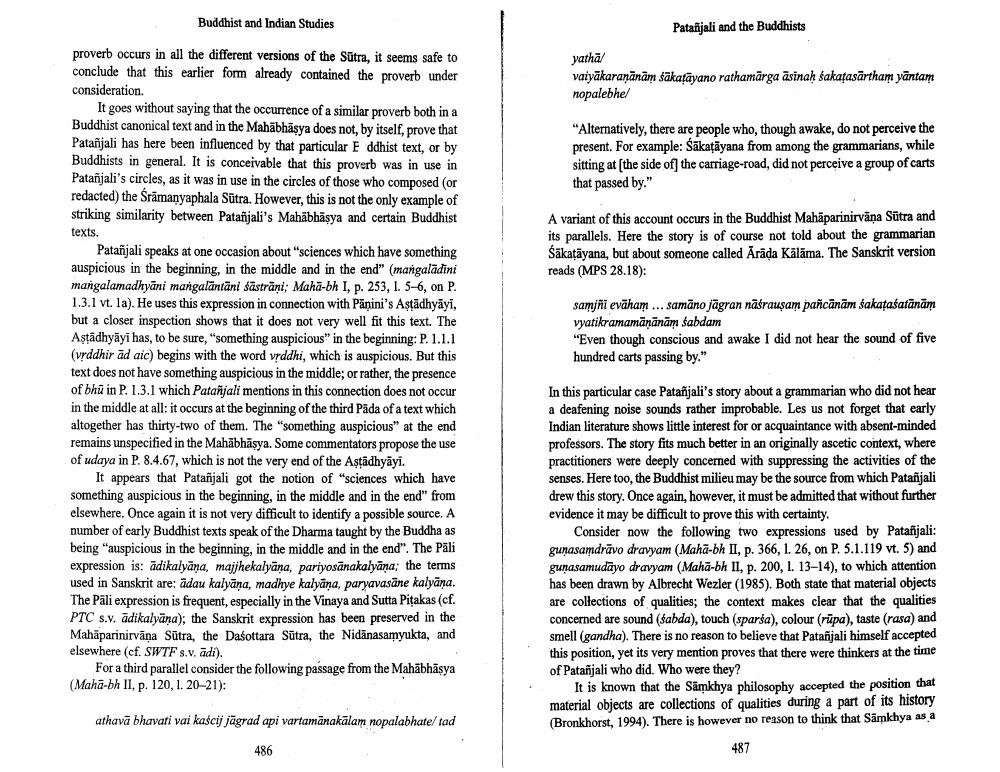Book Title: Patanjali And Buddhists Author(s): Johannes Bronkhorst Publisher: Johannes Bronkhorst View full book textPage 2
________________ Buddhist and Indian Studies proverb occurs in all the different versions of the Sutra, it seems safe to conclude that this earlier form already contained the proverb under consideration. It goes without saying that the occurrence of a similar proverb both in a Buddhist canonical text and in the Mahabhaṣya does not, by itself, prove that Patanjali has here been influenced by that particular E ddhist text, or by Buddhists in general. It is conceivable that this proverb was in use in Patanjali's circles, as it was in use in the circles of those who composed (or redacted) the Śramanyaphala Sutra. However, this is not the only example of striking similarity between Patanjali's Mahābhāṣya and certain Buddhist texts. Patanjali speaks at one occasion about "sciences which have something auspicious in the beginning, in the middle and in the end" (mangaladini mangalamadhyāni mangaläntäni śāstrāṇi; Maha-bh I, p. 253, 1. 5-6, on P. 1.3.1 vt. la). He uses this expression in connection with Panini's Aṣṭādhyāyi, but a closer inspection shows that it does not very well fit this text. The Aṣṭādhyāyi has, to be sure, "something auspicious" in the beginning: P. 1.1.1 (vṛddhir ad aic) begins with the word vṛddhi, which is auspicious. But this text does not have something auspicious in the middle; or rather, the presence of bhu in P. 1.3.1 which Patanjali mentions in this connection does not occur in the middle at all: it occurs at the beginning of the third Päda of a text which altogether has thirty-two of them. The "something auspicious" at the end remains unspecified in the Mahabhāṣya. Some commentators propose the use of udaya in P. 8.4.67, which is not the very end of the Aṣṭadhyayi. It appears that Patanjali got the notion of "sciences which have something auspicious in the beginning, in the middle and in the end" from elsewhere. Once again it is not very difficult to identify a possible source. A number of early Buddhist texts speak of the Dharma taught by the Buddha as being "auspicious in the beginning, in the middle and in the end". The Pāli expression is: adikalyāna, majjhekalyāna, pariyosanakalyana; the terms used in Sanskrit are: adau kalyāṇa, madhye kalyāna, paryavasane kalyāṇa. The Pali expression is frequent, especially in the Vinaya and Sutta Pitakas (cf. PTC s.v. adikalyāna); the Sanskrit expression has been preserved in the Mahāparinirvana Sūtra, the Daśottara Sūtra, the Nidanasamyukta, and elsewhere (cf. SWTF s.v. adi). For a third parallel consider the following passage from the Mahabhāṣya (Maha-bh II, p. 120, 1. 20-21): athava bhavati vai kaścij jāgrad api vartamānakālam nopalabhate/ tad 486 Patanjali and the Buddhists yathal vaiyākaraṇānām sākaṭāyano rathamārga asinaḥ śakaṭasārtham yantam nopalebhe/ "Alternatively, there are people who, though awake, do not perceive the present. For example: Šākaṭāyana from among the grammarians, while sitting at [the side of] the carriage-road, did not perceive a group of carts that passed by." A variant of this account occurs in the Buddhist Mahāparinirvana Sūtra and its parallels. Here the story is of course not told about the grammarian Śākaṭāyana, but about someone called Araḍa Kālāma. The Sanskrit version reads (MPS 28.18): samjñi evāham ... samāno jāgran nāśrauṣam pañcānām śakaṭaśatānāṁ vyatikramamāṇānām sabdam "Even though conscious and awake I did not hear the sound of five hundred carts passing by." In this particular case Patanjali's story about a grammarian who did not hear a deafening noise sounds rather improbable. Les us not forget that early Indian literature shows little interest for or acquaintance with absent-minded professors. The story fits much better in an originally ascetic context, where practitioners were deeply concerned with suppressing the activities of the senses. Here too, the Buddhist milieu may be the source from which Patanjali drew this story. Once again, however, it must be admitted that without further evidence it may be difficult to prove this with certainty. Consider now the following two expressions used by Patañjali: gunasamdravo dravyam (Maha-bh II, p. 366, 1. 26, on P. 5.1.119 vt. 5) and gunasamudayo dravyam (Maha-bh II, p. 200, 1. 13-14), to which attention has been drawn by Albrecht Wezler (1985). Both state that material objects are collections of qualities; the context makes clear that the qualities concerned are sound (sabda), touch (sparsa), colour (rupa), taste (rasa) and smell (gandha). There is no reason to believe that Patanjali himself accepted this position, yet its very mention proves that there were thinkers at the time of Patanjali who did. Who were they? It is known that the Samkhya philosophy accepted the position that material objects are collections of qualities during a part of its history (Bronkhorst, 1994). There is however no reason to think that Sämkhya as a 487Page Navigation
1 2 3 4
